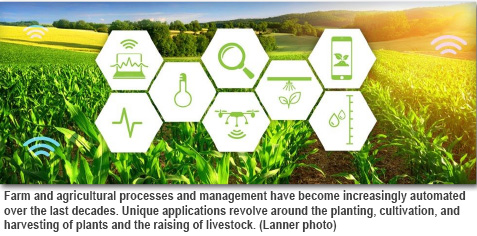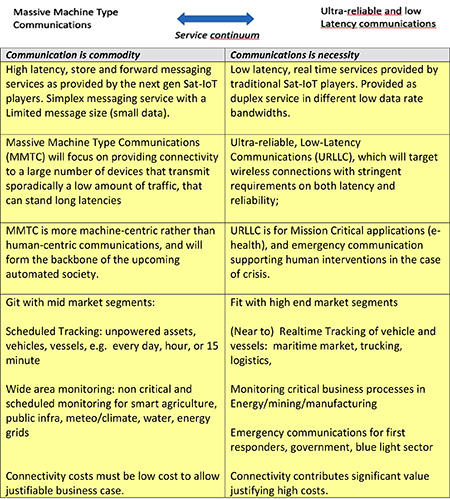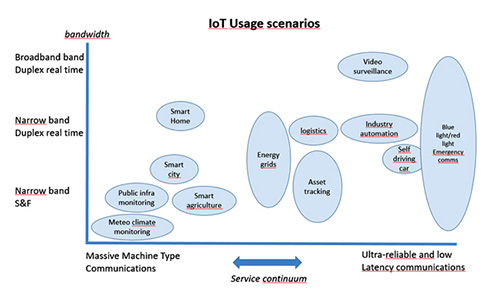IoT Applications, Markets and Opportunities
by Hub Urlings
Amsterdam, The Netherlands, April 1, 2019--After the launch of a whole new generation of small Sat-IoT systems at the end of 2018, the market is looking forward on how these networks are going to fulfill their promise of global low-cost IoT connectivity services. The significant decrease of the overall global IoT connectivity costs and power requirements these new generation Sat-IoT networks bring is expected to lead to a market expansion that will at least equal to the magnitude of this reduction at a factor 25. Expectations, however, are that the market for Sat-IoT may expand way beyond that leading to tens of millions of nodes around the world.
But how will the customers benefit from these low cost global connectivity? And how will this new generation of operators fit in the established Sat-IoT market?
Existing sat-iot services from Inmarsat, Iridium, Globalstar, and Thuraya have dominated the market already for decades, targeting high-end market segments like logistics, the government, or the energy and the mining sector.
 The IoT market is described as the market of million verticals. The vast majority of them (smart home, smart city, connected cars) will be met using terrestrial networks. What market verticals will be able to benefit most from the low-cost, low-power advantages the next gen small Sat IoT operators will offer? How can the new Sat-IoT operators find their niche, and will the high expectations of these new operators and their investors be met?
The IoT market is described as the market of million verticals. The vast majority of them (smart home, smart city, connected cars) will be met using terrestrial networks. What market verticals will be able to benefit most from the low-cost, low-power advantages the next gen small Sat IoT operators will offer? How can the new Sat-IoT operators find their niche, and will the high expectations of these new operators and their investors be met?
In this article we will zoom in on this promising new product market combinations in the satellite IoT market and outline the playing field these new operators will have to work in.
Sat-IoT market size: Yes, but is it is big enough?
To make an estimate on the sat-iot market, we first have to look at the size of the overall IoT market. Where aggressive forecasts put the IoT market at $800 billion by 2025, more conservative scenario puts the IoT market at $300 billion by 2025 (Source: McKinsey Global Institute). Anyone with a better guess is welcome, but one thing is clear: the potential is gigantic.
Within the supplier ecosystem, it is generally expected that software and services suppliers will capture the greatest share of value over time as costs of hardware and overall systems decline, while connectivity will remain a requirement.
The total value of IoT connectivity is estimated to reach 10% of this amount, i.e. between €30 billion and €80 billion. Terrestrial networks like (GSM, Lora, Sigfox and wifi) provide low-cost and low-power connectivity for most use cases in densely populated territories where they have coverage. This includes 95% of the global population but only 10% of the world's surface. Since Sat-IoT is addressing ‘things’ (equipment, assets, vehicles, etc.) in 90% of the globe in less densely populated areas, one could make a conservative estimate of the economic value of the Sat-IoT connectivity to be 5% of that figure. That leads to a total addressable market between €1.5 billion and €4 billion Sat-IoT. This sounds big enough a market to be shared both by traditional and next gen Sat-IoT operators. Let’s zoom in and try to see how.
Sat-IoT service types and their markets
First of all let's put Sat-IoT in perspective and try to understand what small Sat-IoT is offering for that low price. In sync with the 5G pyramid of service types, we can make a service model for satellite IoT connectivity services. The model consists of a continuum where on the left side we see the
 Small Sat IoT and their market fit
Small Sat IoT and their market fit
Small Sat-IoT is very suitable for:
• Low-speed connected sensors with lenient latency requirements, and limited power budgets
• IoT solutions that are deployed globally and/or in areas with little or no coverage by terrestrial networks (rural/remote areas)
Small Sat_IoT is not meant for:
• IoT solutions that produce vast amounts of data, or with strict real-time requirements
• IoT solutions that require bi-directional connectivity
Sat-IoT Market segmentation
The IoT market is sometimes called the market with the million verticals. From a commercialization perspective that is not practical. In this article we will look at the market based on the different IoT service types like described above, then matching it with customer requirements in a number of use cases.
Sat-IoT USAGE scenario’s
Small Sat-IoT markets
In this section we will not deal with the ULLC type of service as provided by traditional sat-iot operators, but we will zoom in on the MMTC type of sat-iot services as provided by the next gen small sat iot operators.
In the non-critical domain there is lots of opportunity for low cost, low power consumption solutions as provided by small sat iot operators:
 The following markets show a good match with the service characteristics of the small sat Iot networks:
The following markets show a good match with the service characteristics of the small sat Iot networks:
Tracking market
Unpowered assets
An example application here is the monitoring hazardous materials in train wagons or other unpowered transport units. As GSM networks do not provide continental coverage, currently these assets can only be monitored by traditional satellite connectivity, and that happens on a small scale already. Current cost levels and power consumption of the traditional Sat-IoT operators, however, are prohibitive to equip e.g. 400,000 additional train wagons.
For that, the customer needs an easy to install, low-cost device, that covers every railroad in every European country with low power consumption and long battery life that is able to do a few transmissions per day to report the current position and cargo info. This makes it a good match, therefore, with Small Sat-IoT connectivity.
The Asset Tracking market is broader, however, with equipment tracking, tracking in the transportation & logistics segment, or the tracking of maritime assets (small boats, yachts, fishing boats).
Monitoring market
Smart-agriculture
Farm and agricultural processes and management have become increasingly automated over the last decades, partaking of the convergence of IT, communications, and automation in other industries. Unique applications revolve around the planting, cultivation, and harvesting of plants and the raising of livestock. The more industrial horticulture, as we see it in the greenhouse sector already, is one of the leading IoT sectors, with a complete sensor/activator based climate control and management of growing conditions. Small sat Iot will take this knowledge and experience out to the fields around the world, promising more productivity, higher yields, less need for detergents, and efficient use of water and nutrients that will justify the use of low-cost sensor networks.
Also global IoT connectivity will allow agri-tech companies to improve supply-chain efficiencies. Via IoT, it is now possible to track the origins of food. To import fish into the EU, you have to prove, as a supplier, that your produce does not come from a maritime reserve; the same applied for certain types of wood. Imagine you could prove your cattle has only grazed in an area with premium grasses. You can then sell the beef as premium as well.
Public infrastructure
In the public infrastructure market, potential applications for small sat IoT include structure and environmental monitoring, asset tracking, and infrastructure maintenance process monitoring and optimization. Coming from the Netherlands, I immediately think of the use of sat-iot in the monitoring dams and dikes to prevent future flooding.
But the market is much broader; think of monitoring of a national road, waterway, railway, waste disposal infrastructure, including all buildings, bridges, structures, etc. Wide area monitoring can help in preventive maintenance or help in monitoring infrastructure that can become dangerous due to lack of maintenance.
Environmental monitoring
A lot of the environmental monitoring applications have a perfect fit with the MMTC sat-iot service type: non-critical, high-latency no problem, low-cost and low-power requirement.
This range of applications is very wide and ranges from:
- weather/meteorological monitoring
- volcanic activity
- monitoring climate change
- water height management
- wild fire monitoring
- drought monitoring
Already satellite images play an important role in this process using earth observation techniques. The addition sensor data from ground-based sensors, however, will enlarge the resolution of the pictures and will provide more detailed insight in the situation.
In terms of “return on investment’ sat-iot solutions for environmental monitoring are difficult to assess. The upside of these applications lies more with what does not happen and were a lot of effect costs can be avoided (based on appropriate reactions to bushfires, floods, natural disasters).
Energy & Utilities
Where return on investment in sat-IoT solutions is clearer is with the monitoring of all kinds of gas, oil, and wind energy grids, both in the upstream and in the downstream. Grid monitoring allows for a more efficient use of the grid against lower cost leading directly to a positive business case.
Another important utility is with water grids. Monitoring here can help with water conservation, predict asset performance, and predict maintenance of the water grid and fresh water reservoirs.
In sum
The Connected World Revolution is in full swing. We will be connected to a vast IoT network that will feed unimaginable amounts of data into ever more advanced artificial intelligence tools, enabling us to create new and highly disruptive products and services that generate huge amounts of wealth, at least for those of us with internet connection.
IoT network operators, both for terrestrial as well as for satellite IoT networks, will have to carve out their specific niche complementing other networks available. This also applies to the new generation Sat-IoT operators that is using small sats to bring the connectivity cost and power consumption of their units (let's call them LPGAN or Low Power Global Area Networks) down to the level of terrestrial Low Power Wide Area Networks (LPWAN) like Lora or Sigfox. Their services are clear and potential markets are identified. Let's see if this new generation Sat-IoT player can turn their startups to profitable business. In the next article, we will go into the challenges these new satellite operators and their service providers face while doing that.
------------------------
 Hub Urlings was one of the pioneers of Satellite M2M as Product Manager Inmarsat-C at the famous KPN Station 12. The reliability and success of this “small data” satellite service, its global coverage and reliability made that the service was used for a myriad of applications.Now, 25 years later, he is again involved in the development of a new generation of Sat-IoT services working as Innovation Manager for the ESA program at Hiber. His company, M2sat, is a value added service provider for Sat-IoT services. He can be contacted at: urlings@m2sat.com.
Hub Urlings was one of the pioneers of Satellite M2M as Product Manager Inmarsat-C at the famous KPN Station 12. The reliability and success of this “small data” satellite service, its global coverage and reliability made that the service was used for a myriad of applications.Now, 25 years later, he is again involved in the development of a new generation of Sat-IoT services working as Innovation Manager for the ESA program at Hiber. His company, M2sat, is a value added service provider for Sat-IoT services. He can be contacted at: urlings@m2sat.com.





